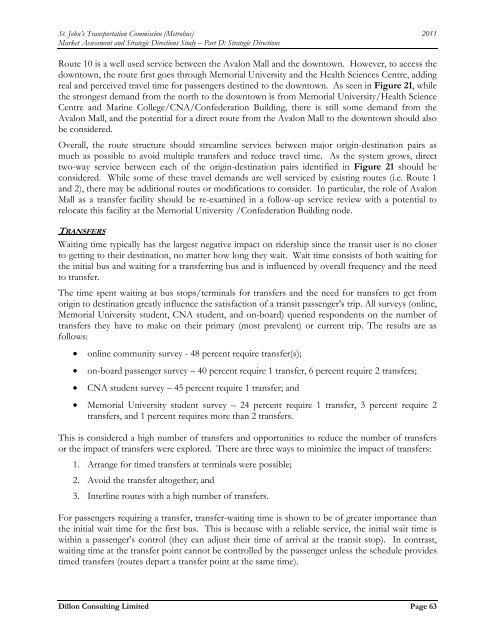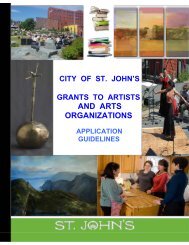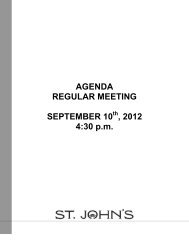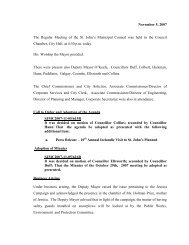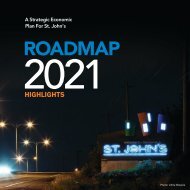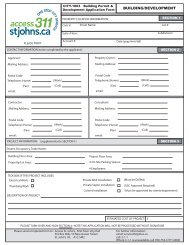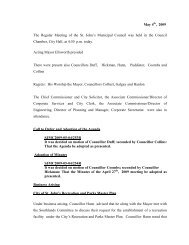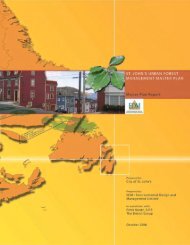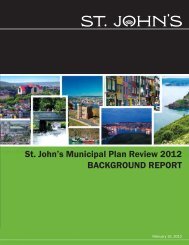Metrobus Transit Study.pdf - City of St. John's
Metrobus Transit Study.pdf - City of St. John's
Metrobus Transit Study.pdf - City of St. John's
Create successful ePaper yourself
Turn your PDF publications into a flip-book with our unique Google optimized e-Paper software.
<strong>St</strong>. John’s Transportation Commission (<strong>Metrobus</strong>) 2011<br />
Market Assessment and <strong>St</strong>rategic Directions <strong><strong>St</strong>udy</strong> – Part D: <strong>St</strong>rategic Directions<br />
Route 10 is a well used service between the Avalon Mall and the downtown. However, to access the<br />
downtown, the route first goes through Memorial University and the Health Sciences Centre, adding<br />
real and perceived travel time for passengers destined to the downtown. As seen in Figure 21, while<br />
the strongest demand from the north to the downtown is from Memorial University/Health Science<br />
Centre and Marine College/CNA/Confederation Building, there is still some demand from the<br />
Avalon Mall, and the potential for a direct route from the Avalon Mall to the downtown should also<br />
be considered.<br />
Overall, the route structure should streamline services between major origin-destination pairs as<br />
much as possible to avoid multiple transfers and reduce travel time. As the system grows, direct<br />
two-way service between each <strong>of</strong> the origin-destination pairs identified in Figure 21 should be<br />
considered. While some <strong>of</strong> these travel demands are well serviced by existing routes (i.e. Route 1<br />
and 2), there may be additional routes or modifications to consider. In particular, the role <strong>of</strong> Avalon<br />
Mall as a transfer facility should be re-examined in a follow-up service review with a potential to<br />
relocate this facility at the Memorial University /Confederation Building node.<br />
TRANSFERS<br />
Waiting time typically has the largest negative impact on ridership since the transit user is no closer<br />
to getting to their destination, no matter how long they wait. Wait time consists <strong>of</strong> both waiting for<br />
the initial bus and waiting for a transferring bus and is influenced by overall frequency and the need<br />
to transfer.<br />
The time spent waiting at bus stops/terminals for transfers and the need for transfers to get from<br />
origin to destination greatly influence the satisfaction <strong>of</strong> a transit passenger’s trip. All surveys (online,<br />
Memorial University student, CNA student, and on-board) queried respondents on the number <strong>of</strong><br />
transfers they have to make on their primary (most prevalent) or current trip. The results are as<br />
follows:<br />
<br />
<br />
<br />
online community survey - 48 percent require transfer(s);<br />
on-board passenger survey – 40 percent require 1 transfer, 6 percent require 2 transfers;<br />
CNA student survey – 45 percent require 1 transfer; and<br />
Memorial University student survey – 24 percent require 1 transfer, 3 percent require 2<br />
transfers, and 1 percent requires more than 2 transfers.<br />
This is considered a high number <strong>of</strong> transfers and opportunities to reduce the number <strong>of</strong> transfers<br />
or the impact <strong>of</strong> transfers were explored. There are three ways to minimize the impact <strong>of</strong> transfers:<br />
1. Arrange for timed transfers at terminals were possible;<br />
2. Avoid the transfer altogether; and<br />
3. Interline routes with a high number <strong>of</strong> transfers.<br />
For passengers requiring a transfer, transfer-waiting time is shown to be <strong>of</strong> greater importance than<br />
the initial wait time for the first bus. This is because with a reliable service, the initial wait time is<br />
within a passenger’s control (they can adjust their time <strong>of</strong> arrival at the transit stop). In contrast,<br />
waiting time at the transfer point cannot be controlled by the passenger unless the schedule provides<br />
timed transfers (routes depart a transfer point at the same time).<br />
Dillon Consulting Limited Page 63


